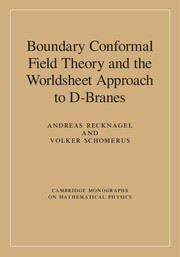Book contents
- Frontmatter
- Dedication
- Contents
- Introduction
- 1 Free field theory with boundaries
- 2 Superstrings and branes
- 3 Conformal field theory on the plane
- 4 Boundary conformal field theory
- 5 Perturbations of boundary conformal field theories
- 6 The Wess–Zumino–Witten model on SU(2)
- 7 Gepner model boundary states and Calabi–Yau branes
- Appendix
- References
- Index
6 - The Wess–Zumino–Witten model on SU(2)
Published online by Cambridge University Press: 05 November 2013
- Frontmatter
- Dedication
- Contents
- Introduction
- 1 Free field theory with boundaries
- 2 Superstrings and branes
- 3 Conformal field theory on the plane
- 4 Boundary conformal field theory
- 5 Perturbations of boundary conformal field theories
- 6 The Wess–Zumino–Witten model on SU(2)
- 7 Gepner model boundary states and Calabi–Yau branes
- Appendix
- References
- Index
Summary
In the preceding chapters, we have discussed general ideas and results of boundary conformal field theory (CFT), but we had only a few relatively simple examples available to illustrate them. Our aim now is to apply some of these techniques to a very instructive case, namely to the so-called Wess–Zumino–Witten (WZW) model on the group manifold SU(2).
In the first section, we introduce the model from its classical action and review properties of its chiral symmetry algebra. This is followed, in Section 6.2, by an algebraic solution of both the bulk and the boundary theory in the spirit of Chapters 3 and 4. In particular, we describe the bulk spectrum and three-point couplings, boundary states, boundary spectra and the three-point couplings of boundary operators.
The third section is devoted to a geometric interpretation of these abstract algebraic constructions. We review two different lines of arguments which suggest that Cardy-type boundary conditions of the SU(2) WZW model are associated with spherical branes, which are localised along special (integer) conjugacy classes of SU(2). Boundary operator products for these branes will be compared to the quantisation of functions on S2. Finally, we compute the low-energy effective action of open strings on SU(2) Cardy branes, which takes the form of a special non-commutative gauge theory on the fuzzy sphere. We study its classical solutions, which provide an insight into boundary perturbations and the dynamics of branes on SU(2).
- Type
- Chapter
- Information
- Publisher: Cambridge University PressPrint publication year: 2013

